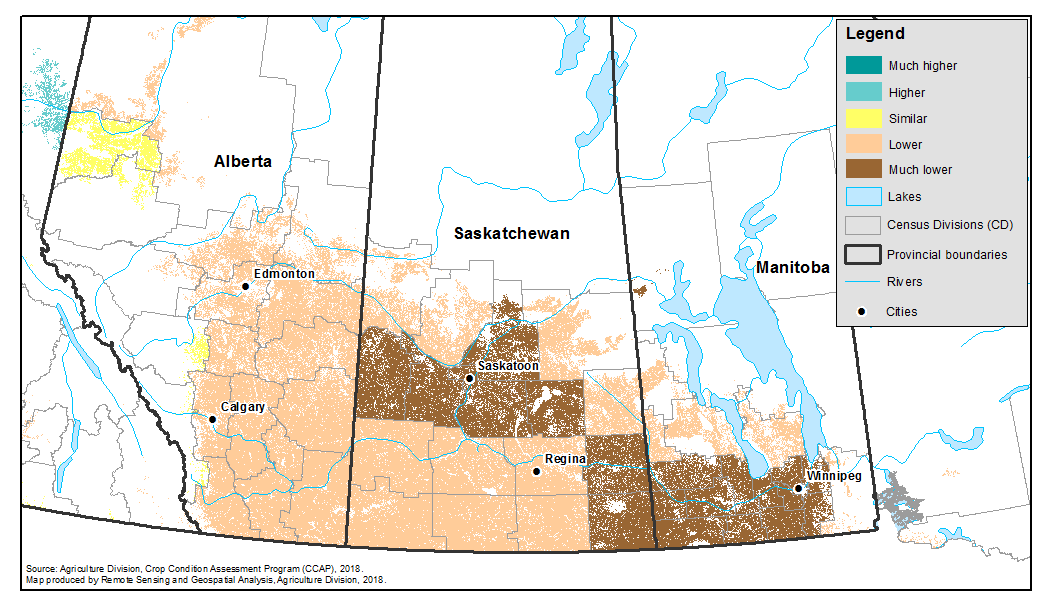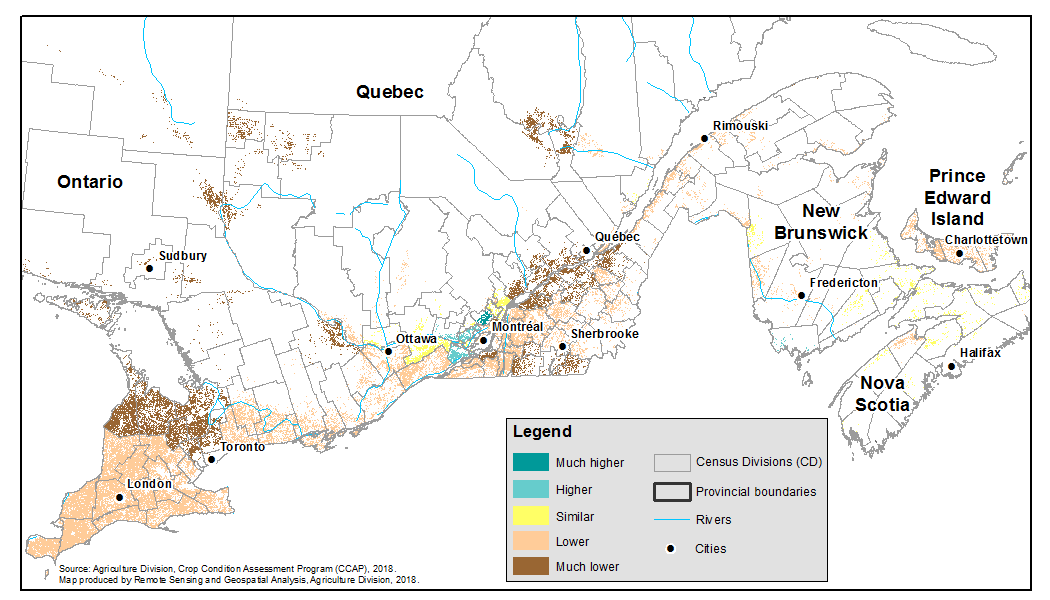Crop Condition Assessment Program, April 9 to October 14, 2018
Archived Content
Information identified as archived is provided for reference, research or recordkeeping purposes. It is not subject to the Government of Canada Web Standards and has not been altered or updated since it was archived. Please "contact us" to request a format other than those available.
Released: 2018-06-01
As of May 27, 2018, crop development was lower to much lower than the normal (as observed from 1987 to 2017) for most parts of Canada, according to the Crop Condition Assessment Program.
Cool conditions in the early spring delayed crop growth and limited planting operations across Canada. Seeding advanced rapidly with the onset of dry, warm weather, particularly in the Prairies. However, a lack of soil moisture across the Prairies remains a concern.
Crop development for most of the Prairies is lower than normal
Crop development was much lower than normal for most of Manitoba as well as southeastern and central Saskatchewan. All other regions of the Prairies were below normal, with the exception of the Peace River region in northern Alberta and British Columbia, where conditions ranged from below normal to higher than normal. Notably, crop development across the Prairies was lower to much lower than conditions recorded during the drought years of 1988, 1989, 2001, and 2002.
Agriculture and Agri-Food Canada reported that between the start of the growing season and May 24, large portions of the Prairies had received less than 40% of average rainfall.
Crop conditions vary across Central and Atlantic Canada, ranging from much lower to much higher than normal
Crop conditions ranged from below normal to much below normal across Ontario and Quebec, with the exception of a region north of Montréal where conditions were much higher than normal. Conditions ranged from below normal to normal in parts of New Brunswick and Nova Scotia, but below normal in Prince Edward Island and Newfoundland and Labrador as a result of delayed planting due to a cool spring.
Variable crop development observed in British Columbia
Crop conditions were similar to normal for Kamloops and the Peace River region in British Columbia, but were below normal for the Williams Lake region and the Fraser Valley.
Note to readers
Agriculture and Agri-Food Canada has partnered with Statistics Canada to provide the Crop Condition Assessment Program (CCAP). The Canada Centre for Mapping and Earth Observation, part of Natural Resources Canada, has also contributed by providing software for processing the input satellite data.
The 2018 version of the satellite-based CCAP application uses a new design where all components are available on a single page.
In addition, historical values (1987 to 2017) are available in CANSIM. These values are derived from the one-kilometre resolution satellite picture elements within each census agriculture region, census division or census consolidated subdivision of Canada that contains pasture and/or cropping. The inter-annual weekly reference period is from mid-April to mid-October.
The CCAP is a free web mapping application that provides timely, objective cropland and pasture monitoring information on a weekly basis for Canada's entire agricultural region, as well as the northern part of the United States.
The application combines state-of-the-art satellite remote sensing with geographic information systems and dynamic web mapping technologies. It is the longest running program of its kind in Canadian history.
Satellite imagery is received every Monday from early April until mid-October. Weekly updates are made to the web application within minutes of receiving the satellite data for near real-time use by the entire agriculture community.
Current conditions are compared with a 31-year normal, allowing easy mapping of areas under stress, such as drought, flooding or frost events. The web application includes other features such as thematic maps and data in graph and tabular format for four types of different geography layers, from the census agriculture region to the township level. The entire historical database from 1987 onward is included in the application.
Data from the CCAP are available in CANSIM table 001-0101 and will be updated periodically.
Products
The publication Crop Condition Assessment Program, 2018 (22-205-X), is now available online.
Weekly satellite images from the start of the 2018 growing season have been processed and are now available on the Crop Condition Assessment Program website.
Contact information
For more information, or to enquire about the concepts, methods or data quality of this release, contact us (toll-free 1-800-263-1136; 514-283-8300; STATCAN.infostats-infostats.STATCAN@canada.ca) or Media Relations (613-951-4636; STATCAN.mediahotline-ligneinfomedias.STATCAN@canada.ca).
- Date modified:



